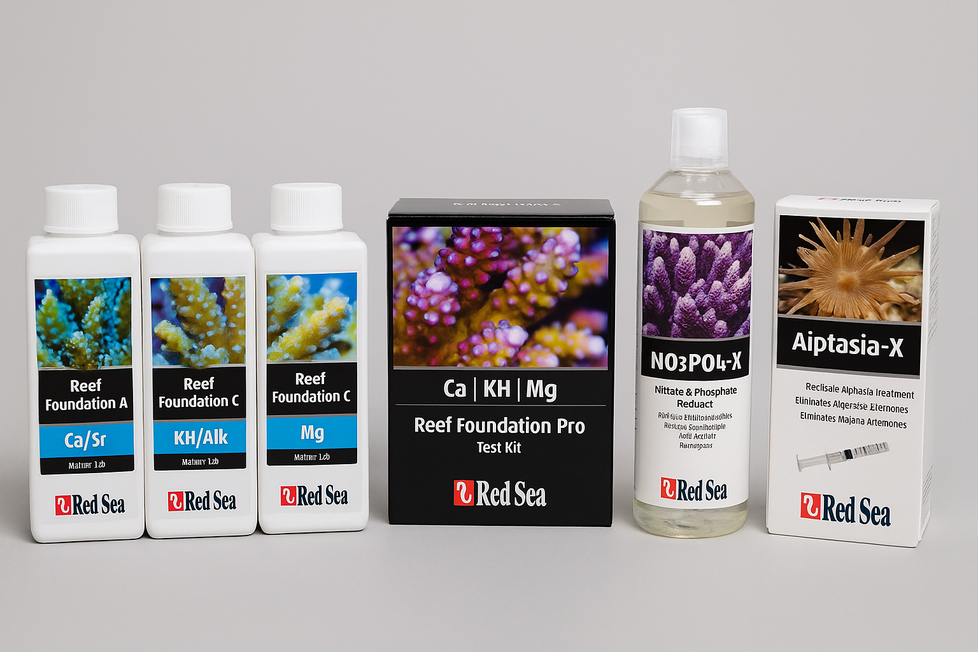Understanding and maintaining balanced reef chemistry is essential for coral growth, health, and coloration. One of the most widely trusted dosing systems in the reefing community is the Red Sea Reef Foundation range. Comprising three precisely formulated components—Reef Foundation A, B, and C—this system provides everything needed to support skeletal development and long-term coral vitality.
In this guide, we’ll break down what each supplement does, how to dose it effectively, and how to pair it with Red Sea test kits for professional-level reef care.
What Is Red Sea Reef Foundation?
Red Sea’s Reef Foundation system is designed to replenish key building blocks that corals consume during growth. These are the major elements required for proper coral calcification, which forms their hard skeletons.
Reef Foundation A (Calcium + Strontium)
This component provides calcium, a core structural element in coral skeletons, along with strontium and barium, which enhance skeletal density and stability.
Reef Foundation B (Alkalinity Buffer)
This part maintains carbonate hardness (KH), which is crucial for pH stability and coral skeleton formation. It helps corals absorb calcium more efficiently.
Reef Foundation C (Magnesium)
Magnesium plays a supportive role by preventing excessive calcium precipitation and stabilizing alkalinity. It also promotes stronger coral tissue.
Together, these three components form the chemical backbone of successful reef tank growth, especially in SPS-dominated systems.
How to Dose Reef Foundation A, B & C
Dosing should be based on regular water testing using Red Sea’s Reef Foundation Pro Test Kit, which measures calcium, alkalinity, and magnesium with high precision
Step-by-Step Dosing Method:
-
Test your tank’s current levels of Ca, KH, and Mg using the Pro kit.
-
Compare your results against target levels (Ca 430–450 ppm, KH 8–9 dKH, Mg 1280–1350 ppm).
-
Refer to the Red Sea dosing chart included with the products or use the Reef Program online calculator.
-
Dose the corresponding A, B, or C supplements in equal parts if your tank is balanced, or adjust individually if specific parameters are off.
Dosing can be manual or automated via a dosing pump. Stability is more important than perfection—aim for slow, consistent adjustments rather than rapid corrections.
Pro Tips for Success
-
Dose Foundation A, B, and C in equal parts when your parameters are proportionally low, as this keeps the ionic balance correct.
-
Avoid dosing Foundation A and Foundation B at the same time, as calcium and carbonates can precipitate when added together. Dose them a few hours apart if needed.
-
Test at least 2–3 times per week during the first few months or whenever corals are growing rapidly.
-
Use a dosing container system for clean, stable administration if you’re automating.
Why Is It Better Than All-in-One Supplements?
Many all-in-one additives lack individual adjustability. Red Sea’s Foundation approach lets you tailor each component to your reef’s needs. This is especially important for tanks with varying coral types or higher biological loads. For reefers aiming for precision and long-term growth, separating Ca, KH, and Mg provides better control and fewer imbalances.
Where to Get Red Sea Reef Foundation Products
You can find Reef Foundation A, B, and C, as well as test kits and accessories, in the Red Sea Maintenance Collection at Charterhouse Aquatics. We offer fast UK shipping and expert support to help you get the most out of your reef care routine.



